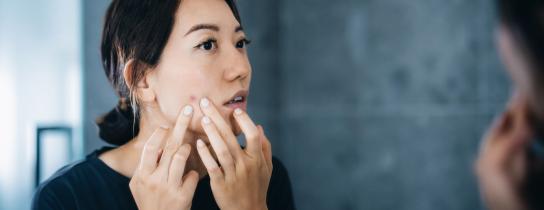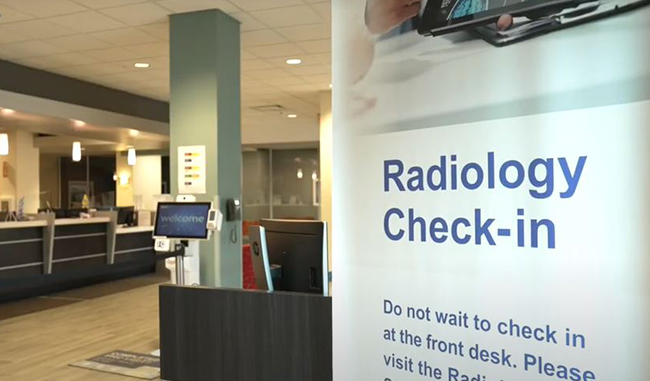
Acne vs. Pimples: They Aren’t Exactly the Same Thing
Pimples can happen from time to time. When they pop up repeatedly, it could be acne.
People often use the words “pimples” and “acne” interchangeably. They’re related, but not the same thing. Pimples are individual lesions, while acne is a chronic skin condition.
For many people, these textured or inflamed bumps on the face can be more than just annoying. Acne can have lasting negative effects on mental health.
However, several effective treatments are available for both pimples and acne. It’s important to know that acne treatments do take time, so if a person thinks they may have acne instead of pimples they should speak to a provider as soon as possible for treatment.
What’s the difference between acne and pimples?
Pimples are a specific type of acne. They are individual sores or lesions that can occur on the skin. They are usually raised, red or discolored bumps with a white or yellow center that contains pus.
Acne, also known as acne vulgaris, is an inflammatory skin condition, and pimples are a symptom. Acne can also have other skin conditions similar to pimples, which can be more painful and harder to get rid of, sometimes even needing a physician to remove them with specific chemicals or surgical equipment.
Both can happen in people of any age, but tend to occur especially among teens and young adults.
Causes
Acne is characterized by multiple pimples that appear repeatedly over a prolonged period. But what causes pimples?
Causes of pimples
Pimples are essentially inflamed hair follicles. They happen when bacteria and sebum get trapped in a hair follicle, triggering the skin around it to become inflamed.
Pimples aren’t the same as the itchy bumps or welts on the skin that can arise due to an allergic reaction. These are called hives or urticaria.
Bigger-picture causes of acne
Acne is a skin condition that causes the prolonged appearance of pimples. Pimples can happen in acne due to several factors that often work together:
- Genetics: Acne can be hereditary. It may be related to multiple factors, such as inherited differences in the fatty acid composition of sebum.
- Certain types of bacteria: The presence of certain strains of the bacterium Cutibacterium acnes can cause inflammation in the skin.
- Overproduction of androgens: Testosterone is one type of androgen. Overproduction isn’t usually a cause of acne, but it can happen in some cases, like in people with polycystic ovarian syndrome (PCOS).
- Elevated sebum production: When the sebaceous glands produce higher levels of sebum, an oily substance that acts as a skin moisturizer under regular circumstances, but also feeds the bacteria that cause acne.
- Menstrual cycle: Acne flare-ups in women can happen at certain times of their menstrual cycle since the secretion of sebum is related to hormone levels, which change across the cycle.
Besides hormones, genetics and bacteria, pimples and acne can also be due to environmental or outside factors. These can include:
- Too much sun exposure
- Certain medications, like steroids
- Clothing and accessories that cover or press on the skin, like headbands, underwear straps or backpacks
- Stress
- Cosmetics that contain oil
- Massage with oil
- Insulin resistance
Contrary to popular myths, there’s no evidence of a link between hygiene and acne.
Characteristics
Pimples and acne mainly happen on the face, but some people also get them on their chest, back or upper arms.
Characteristics of pimples
Several different types of pimples or lesions can be present in a person with acne. They all look a little bit different:
- Whiteheads: A white bump that forms when a plugged hair follicle becomes infected under the surface of the skin. These are also called closed comedones.
- Blackheads: These appear as black dots on the skin. They are hair follicles plugged with sebum that are open to the air. The sebum has turned a dark color due to exposure to air. These are also called open comedones.
- Papules: Small bumps that can hurt when touched.
- Pustules or pimples: They may have a red ring around the base. These are often what first comes to mind when we think of “pimples.” They happen when white or yellow pus collects under the skin in response to bacterial infection in hair follicles.
- Nodules: When the hair follicle infection happens deeper in the skin, it forms a large, painful bump.
- Cysts: Deep lesions that contain pus-like boils and are tender to the touch.
Acne types
A person with acne experiences multiple, recurring pimples or lesions over an extended period.
Beyond common acne vulgaris, there are other less common subtypes of acne:
- Acne conglobata: A severe type of acne that happens mainly in adolescent boys and includes interconnected pimples, nodules, or cysts, but no systemic symptoms such as fever.
- Acne fulminans: A type of severe inflammatory acne that happens most often in adolescent boys, sometimes with fever or polyarthritis.
- Infantile acne: Acne that can happen in babies usually between 3 and 6 months of age.
Treatment options
A dermatologist can help create a treatment plan for stubborn pimples that don’t go away with home treatment.
How to treat an individual pimple
When a pimple forms, there are a few ways to help it heal faster, but treatment can depend on the type of pimple.
Here are a few tips:
- Wash with a benzoyl peroxide or salicylic acid cleanser twice a day to remove the bacteria and sebum that may be causing the pimple.
- Leave pustules alone — don’t try to pop them, since it can make acne worse.
- Don’t scrub blackheads. It can cause more inflammation, which can worsen the situation.
How to reduce acne and help prevent it
There are three primary goals in treating acne:
- Heal existing lesions
- Prevent new ones from forming
- Minimize scarring
Oral medicines and topical treatments can help with reaching these goals. There are both at-home methods and clinical methods that can help minimize the occurrence and appearance of acne and acne scarring.
Dermatologists, doctors who specialize in the skin, can help people choose the right treatments for their acne.
Topical acne treatments include:
- Antibiotic cream or ointment: Prescription medication that kills bacteria.
- Benzoyl peroxide and other over-the-counter treatments: Kills bacteria and may reduce sebum production.
- Salicylic acid: Reduces the buildup of skin cells within the hair follicles and helps break down blackheads and whiteheads.
- Retinoids: Help heal and prevent acne lesions and scarring and reduce inflammation. The retinoid adapalene is available without a prescription. Others require a prescription.
- Sulfur: Breaks down whiteheads and blackheads.
Oral medicines, which will need a prescription from a doctor, for acne include:
- Antibiotics: Kill bacteria and help reduce inflammation.
- Isotretinoin: Helps open the pores and improves the effectiveness of topical medications.
- Hormone therapy: Reduces the effects of androgens, such as testosterone, on the sebaceous glands. Doctors sometimes recommend oral birth control as a hormone therapy for females.
- Oral corticosteroids: Help reduce skin inflammation.
Other treatments a dermatologist may offer to treat acne include:
- Light therapy
- Corticosteroid injections
- Chemical peels (applied by a doctor)
- Surgery to treat scarring
Dermatologists may also recommend lifestyle modifications to reduce the risk of acne breakouts. Habits that can help include:
- Using a water-based moisturizer for dry skin.
- Removing makeup before bed every night.
- Washing hair regularly.
- Considering limiting milk consumption since it’s linked with acne in some people.
- Not irritating the skin with overwashing, scrubbing or using water that’s too hot.
- Not picking at pimples, as this is more likely to cause permanent scarring and spread the infection.
Takeaway
Pimples are individual lesions. If a person has only one or two pimples, they may not have acne.
Acne is a chronic condition characterized by multiple recurring pimples or lesions on the skin.
Effective treatments are available. Working with a doctor as soon as acne starts becoming an issue is the fastest way to resolve it and minimize scarring.
At Crystal Run, our dermatologists diagnose and treat conditions and diseases of the skin, scalp, hair, and nails with both medical and surgical interventions. Our dermatologists treat a wide variety of dermatologic conditions, from acne and psoriasis to rosacea and shingles. Schedule an appointment today!
- Acne. (2021). https://kidshealth.org/en/teens/acne.html
- Acne. (2023). https://www.niams.nih.gov/health-topics/acne
- Acne can affect more than your skin. (n.d.). https://www.aad.org/public/diseases/acne/acne-emotional-effects
- Hafsi W, et al. (2023). Acne conglobata. https://www.ncbi.nlm.nih.gov/books/NBK459219/
- How to treat different types of acne. (2023). https://www.aad.org/public/diseases/acne/diy/types-breakouts
- Is that acne on my baby’s face? (2023). https://www.aad.org/public/diseases/acne/really-acne/baby-acne
- Ludmann P. (2024). Hives: FAQs. https://www.aad.org/public/diseases/a-z/hives-overview
- Pakkam M. (2025). The effect of dairy products on acne vulgaris. https://link.springer.com/chapter/10.1007/978-3-031-83677-0_2
- Polycystic ovary syndrome (PCOS). (2021). https://kidshealth.org/en/teens/pcos.html
- Saleh HM, et al. (2025). Acne fulminans. https://www.ncbi.nlm.nih.gov/books/NBK459326/
- Skin conditions by the numbers. (2025). https://www.aad.org/media/stats-numbers
- Sutaria AH, et al. (2023). Acne vulgaris. https://www.ncbi.nlm.nih.gov/books/NBK459173/

 Optum Radiology at Crystal Run Healthcare
Optum Radiology at Crystal Run Healthcare Request medical records online
Request medical records online